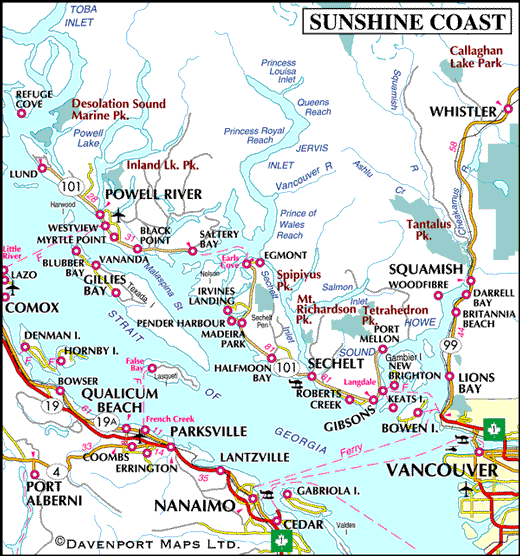Premier Listings for Savary Island
Dazzling sunlight, glorious sunsets, and moonlit nights on sandy beaches all combine to bring the glamour of the tropics to Savary Island, a paradise island in British Columbia’s Strait of Georgia.
The crescent-shaped Savary Island is unlike most of the Gulf Islands in that the island runs east-west, an 8-km long, 1-km wide clay ridge covered in sand – an atypical landscape which most resembles a hideaway in the south seas.
Any island with natural attributes such as these is attractive, but Savary still has more. An atmosphere of history pervades the place, highlighted by tales of coastal Indians using it as a principal summer meeting spot, and stories of Natives fortifying Indian Point, the western tip, against marauding bands from other tribes. Vast middens of empty clam shells have been found at various places on the island.
Captain George Vancouver records in his journal for June 1792 that he sailed past an island lying in an east-west direction, “having beauty such as we have seldom enjoyed”, which he named Savary’s Island. He left no indication of who Savary was, which remains a mystery to this day. The island was occupied at that time, and for an estimated 4,500 years before that, by the Coast Salish (Sliammon ancestors) First Nations who, influenced by the shape of the island, called it Ayhus, meaning double-headed serpent. The greedy serpent is said to have been trying to reach its cave on Hurtado Point when the Transformer spotted it from the sky and changed it into this island.
Without a doubt, the best beaches in the entire chain of Gulf Islands are to be found on Savary Island. Unfortunately, few visitors travelling without a boat will get the opportunity to stroll along them. It’s debatable which side of the snout-shaped island has the best beaches, but when you’re in heaven, it doesn’t matter which side of the street you walk on!
The current year-round population of Savary increases to over 2,000 in the summer months. Many summer cabin owners have been coming to Savary Island for generations. There are no paved roads on the island, and few cars, but transportation is available by taxi.
Population: 100
Location: Savary Island is located in the Strait of Georgia, northwest of Powell River and 4 miles (6 km) offshore from Lund on the Sunshine Coast of BC. Savary Island and the Copeland Islands Provincial Marine Park are only accessible by private boat and water taxi from Lund, or by charter airline. Savary Island is not serviced by a public ferry, so transportation is limited. If you do have a boat, kayak, or canoe, the First or Second Beaches on the island’s north side are the easiest to reach.
Savary Island is unique in Canada, belonging to the Garry Oak ecosystem, one of the most endangered habitats in the country. Approximately 30% of the 1,111-acre island is developed, with virtually no protected land. The Savary Island Land Trust Society is urgently working to establish protected areas on the island, in order to preserve groundwater, habitat, biodiversity and heritage sites.
Beaches: Savary offers vast beaches and terrific swimming in clear, warm waters on the north shore; big rollers and great surfing on the south. South Beach is the island’s clothing optional beach, which is popular with day trippers who boat over to the island. The tides moving from the north and south of the Georgia Strait meet just north of Savary, causing little water movement, creating wonderful sun-baked warm waters.
Eco Power: There is no electricity on Savary – the island’s residents make themselves comfortable with solar, propane, and other ecologically-friendly power sources.
Arbutus Trees: Walk across the island to the north shore and view some unusually large Arbutus trees, one of which is said to be the largest in British Columbia, located on private property on the north shore.
Mace Point: Most yachtsman cruising in British Columbia’s inland coastal waters pass by Mace Point (formerly Green Point), the eastern tip of Savary Island, on their way north to Desolation Sound and beyond. Few stop, however, thus missing one of the gems in this area.
Flora: Owing to the warm nature of the soil and its sheltered position, the flora is different from that of the rockbound coast and other islands. One spot on Savary may be like a desert, while a few hundred yards away there is a dense growth of tall ferns, moss, salal, and a wealth of wild blueberries, huckleberries, and blackberries. In spring Savary enjoys a profusion of wildflowers – sea blush, camas, rattlesnake plantain, fawn and chocolate lilies to name but a few.
Wildlife: All of this offers sanctuary to deer, some of them quite tame, and also to a wide variety of birds. Bald eagles are a familiar sight, while bird watchers can delight in the swallows, hummingbirds, thrush, sparrows, woodpeckers, kingfishers, screech owls, great blue herons, sandpipers, and sea birds of various kinds, including loons and seagulls. There are no bears, cougars or raccoons on Savary Island.
Lodging: Savary Island has no campground, but does have a few bed and breakfasts.
Keefer Bay: A public wharf and moorage floats are located in Keefer Bay.
Hiking: Beautiful hiking trails are found everywhere on Savary Island – shady woodland trails bordered by tall lacy ferns.
Shellfish: The foreshore of Savary abounds in marine resources, including one of the richest commercial clam fisheries in British Columbia.
Floatplanes: In the summer time, Daddy Flights are a common sight, as floatplanes bring fathers to Savary Island to join their families for the weekend.
Kayaking: From Lund, kayakers can see the white sandy beaches on Savary beckoning in the distance, while the Copeland Islands (or Raggeds as they are also known locally) lie out of sight to the north. To reach Savary, paddle south from Lund along the peninsula’s shoreline to the closest point to Savary, then paddle west for 30 minutes, or about 1 mile (1.6 km).
Copeland Islands Marine Provincial Park: To reach the Copeland Islands, head north from Lund, hugging the steep-sided coastline. Marine traffic in Thulin Passage can kick up a sizable chop; thus, it’s best to set out as early in the day as possible before many large pleasure craft begin to ply these waters. Pick your opening and paddle hard to cover the 0.6 mile (1 km) between the peninsula and the most southerly island in this chain. Once in the vicinity of the Copelands, you’ll find sheltered paddling that you’ll have to share only with the numerous seals that haul up on little islets when not fishing for their next meal. Shellfish are particularly abundant. Although the seven major islands in the Copelands are quite rugged, with limited level terrain, a handful of campsites are tucked away on the sheltered north side of the third from the top of the chain. There are no facilities here, no freshwater, and campfires are prohibited. Pack out everything except your oyster shells, though you’ll probably want to keep one as a memento.
Premier Listings

Biographical Info
It’s a Coastal Lifestyle … Live It!
Specializing in marketing and selling local residential, recreational, unique oceanfront and commercial real estate throughout Campbell River, northern Vancouver Island, Discovery Islands, the Outer Islands and the BC Mainland Coast. Our real estate listings include homes to small oceanfront and lakefront recreational lots, private islands, remote island acreages, fishing lodges, wilderness / adventure resorts and vacation homes, oceanfront / lakefront cabins, marinas, remote & timbered acreages, and development investment properties on the west coast of BC and Vancouver Island – BCO has the Coast covered!
The BC Oceanfront Real Estate Team loves to bring people to the coast and introduce people to the coastal lifestyle. All members of the team live an active coastal lifestyle, and they bring that passion for the coast to all that they do. All three agents have their own boats and are very familiar with the many different regions surrounding central and northern Vancouver Island. With a team behind you, you can be sure that someone is always at hand to answer questions and lend assistance.



